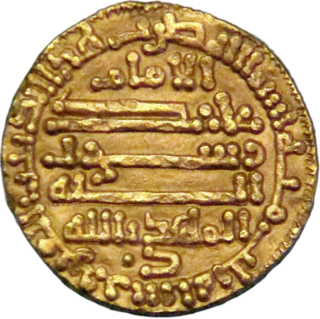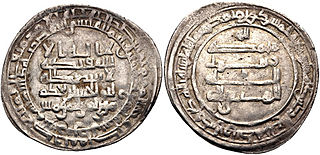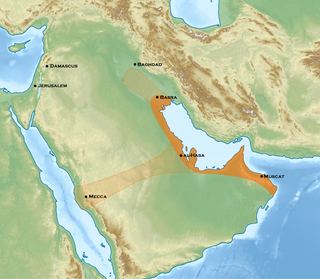Related Research Articles

Abū Muḥammad ʿAbd Allāh ibn al-Ḥusayn, better known by his regnal name al-Mahdī biʾllāh, was the founder of the Isma'ili Fatimid Caliphate, the only major Shi'a caliphate in Islamic history, and the eleventh Imam of the Isma'ili branch of Shi'ism.

Abū Muḥammad ʿAlī ibn Aḥmad, better known by his regnal name al-Muktafī bi-llāh, was the caliph of the Abbasid Caliphate from 902 to 908. More liberal and sedentary than his militaristic father al-Mu'tadid, al-Muktafi essentially continued his policies, although most of the actual conduct of government was left to his viziers and officials. His reign saw the defeat of the Qarmatians of the Syrian Desert, and the reincorporation of Egypt and the parts of Syria ruled by the Tulunid dynasty. The war with the Byzantine Empire continued with alternating success, although the Arabs scored a major victory in the Sack of Thessalonica in 904. His death in 908 opened the way for the installation of a weak ruler, al-Muqtadir, by the palace bureaucracy, and began the terminal decline of the Abbasid Caliphate that ended in 946 with the caliphs becoming puppet rulers under the Buyid dynasty.

Abu Ishaq Ibrahim ibn Jaʿfar al-Muqtadir better known by his regnal title al-Muttaqi was the Abbasid Caliph in Baghdad from 940 to 944. His reign marked the start of the 'later Abbasid period' (940–1258).

The Qarmatians were a militant Isma'ili Shia movement centred in al-Hasa in Eastern Arabia, where they established a religious—and, as some scholars have claimed, proto-socialist or utopian socialist—state in 899 CE. Its members were part of a movement that adhered to a syncretic branch of Sevener Ismaili Shia Islam, and were ruled by a dynasty founded by Abu Sa'id al-Jannabi, a Persian from Jannaba in coastal Fars. They rejected the claim of Fatimid Caliph Abdallah al-Mahdi Billah to imamate and clung to their belief in the coming of the Mahdi, and they revolted against the Fatimid and Abbasid Caliphates.
Abū'l-Ḥasan Mu'nis al-Qushuri, also commonly known by the surnames al-Muẓaffar and al-Khadim, was the commander-in-chief of the Abbasid army from 908 to his death in 933 CE, and virtual dictator and king-maker of the Caliphate from 928 on.
Abu Tahir Sulayman al-Jannabi was a Persian warlord and the ruler of the Qarmatian state in Bahrayn, who in 930 led the Sack of Mecca.
Abu Sa'id Hasan ibn Bahram al-Jannabi was a Persian and the founder of the Qarmatian state in Bahrayn. By 899, his followers controlled large parts of the region, and in 900, he scored a major victory over an Abbasid army sent to subdue him. He captured the local capital, Hajar, in 903, and extended his rule south and east into Oman. He was assassinated in 913, and succeeded by his eldest son Sa'id.
Abu Bakr Muhammad ibn Ra'iq, usually simply known as Ibn Ra'iq, was a senior official of the Abbasid Caliphate, who exploited the caliphal government's weakness to become the first amir al-umara of the Caliphate in 936. Deposed by rival Turkish military leaders in 938, he regained the post in 941 and kept it until his assassination in February 942.
Husayn ibn Hamdan ibn Hamdun ibn al-Harith al-Taghlibi was an early member of the Hamdanid family, who distinguished himself as a general for the Abbasid Caliphate and played a major role in the Hamdanids' rise to power among the Arab tribes in the Jazira.

Abu'l-Hasan Ali ibn Muhammad ibn Musa ibn al-Hasan ibn al-Furat was a senior official of the Abbasid Caliphate who served three times as vizier under Caliph al-Muqtadir. Ali emerged into prominence as an able fiscal administrator and deputy to his older brother Ahmad. Eventually he came to lead one of the two major and rival court factions during al-Muqtadir's caliphate, the Banu'l-Furat, the other being the group of officials around the commander-in-chief Mu'nis al-Muzaffar and the vizier Ali ibn Isa al-Jarrah.
Al-Husayn ibn Zakarawayh, also known under his assumed name Sahib al-Shama, was a Qarmatian leader in the Syrian Desert in the early years of the 10th century.
Yahya ibn Zakarawayh, also known under his assumed name Sahib al-Naqa, was a Qarmatian leader in the Syrian Desert in the early years of the 10th century.
Abu'l-Qāsim Abdallāh ibn Muḥammad al-Khāqānī was a son of the Abbasid vizier Muhammad ibn Ubayd Allah al-Khaqani, under whose vizierate in 912–913 he actually ran the government, before becoming vizier himself in 924–925.
Hamdan Qarmat ibn al-Ash'ath was the eponymous founder of the Qarmatian sect of Isma'ilism. Originally the chief Isma'ili missionary in lower Iraq, in 899 he quarreled with the movement's leadership at Salamiya after it was taken over by Sa'id ibn al-Husayn, and with his followers broke off from them. Hamdan then disappeared, but his followers continued in existence in the Syrian Desert and al-Bahrayn for several decades.
The Fatimid conquest of Egypt took place in 969 when the troops of the Fatimid Caliphate under the general Jawhar captured Egypt, then ruled by the autonomous Ikhshidid dynasty in the name of the Abbasid Caliphate.
Abu Abdallah al-Hasan al-Baridi was the most prominent of the Baridi family, Iraqi tax officials who used the enormous wealth gained from tax farming to vie for control of the rump Abbasid Caliphate in the 930s and 940s.
Abu Shuja Kurankij ibn Faradi was a Daylamite military commander who briefly became amir al-umara of the Abbasid Caliphate in July–August 941.

The Sack of Mecca occurred on 11 January 930, when the Qarmatians of Bahrayn sacked the Muslim holy city amidst the rituals of the Hajj pilgrimage.
The Qarmatian invasion of Iraq was a large-scale raid by the Qarmatians of Bahrayn against the Abbasid Caliphate's metropolitan region of Iraq, that began in autumn of 927 and continued until the summer of 928.
The Sack of Basra was the capture and looting of the Abbasid city of Basra by the Qarmatians of Bahrayn, and took place in August 923. It was the first of a series of Qarmatian attacks, that culminated in an invasion of Iraq in 927–928.
References
- ↑ Halm 1991, pp. 37–38, 58–60.
- ↑ Daftary 2007, pp. 116–117, 121.
- 1 2 Kennedy 2004, p. 287.
- ↑ Halm 1991, pp. 176, 225–226.
- ↑ Daftary 2007, pp. 121, 147–148.
- 1 2 3 4 5 6 7 8 Halm 1991, p. 226.
- ↑ Kennedy 2004, p. 191.
- ↑ Kennedy 2013, p. 34.
- ↑ Kennedy 2013, pp. 33–34.
- 1 2 3 Amedroz & Margoliouth 1921, p. 134.
- ↑ Kennedy 2004, p. 288.
- ↑ Halm 1991, pp. 226–227.
- ↑ Amedroz & Margoliouth 1921, pp. 134–135.
- ↑ Halm 1991, p. 227.
- ↑ Halm 1997, pp. 298–299.
- ↑ Kennedy 2013, p. 33.
- ↑ Kennedy 2004, pp. 191–192.
- 1 2 Kennedy 2013, p. 35.
- ↑ Halm 1991, pp. 227–229.
- ↑ Kennedy 2013, pp. 35–39.
- ↑ Daftary 2007, p. 149.
- ↑ Halm 1991, pp. 229–230.
- ↑ Daftary 2007, pp. 149–151.
- ↑ Halm 1991, pp. 230–236.
- ↑ Kennedy 2004, pp. 288–289.